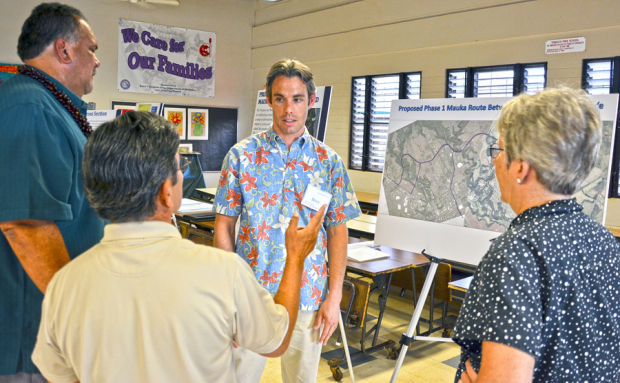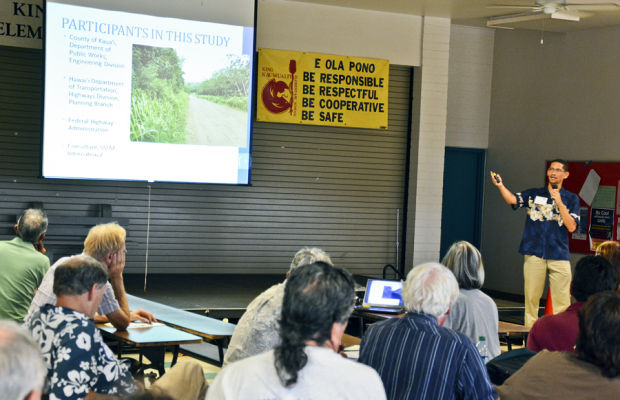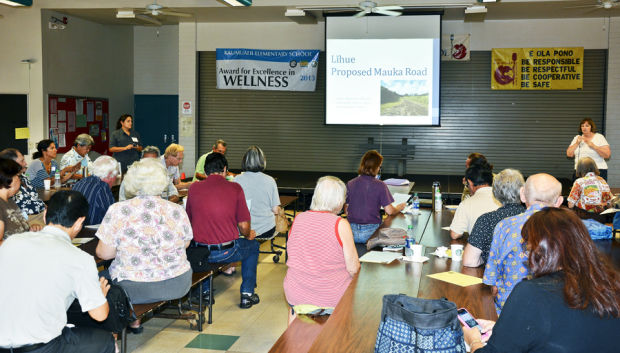HANAMAULU — For nearly four decades, a long-term plan for a bypass road located mauka of Lihue and Hanamaulu was spelled out on the county’s books.
But for most of that time, plans for the 5.5-mile roadway, which would traverse across old cane haul roads from Hanamaulu to Lihue, remained buried in a handful of county plans dating back to at least 1976.
That all changed on Thursday, when county officials unveiled their initial plans for the road, which they say would alleviate traffic congestion through one of the island’s most condensed population centers.
“We have talked to the state DOT (Department of Transportation) and we feel that, if the road is built into one, it would probably become one of the most important regional connections and would fit into their description of a regional route,” County of Kauai Engineering Chief Michael Moule said.
The county’s current plans for the road, outlined in a feasibility study conducted by Honolulu-based engineering firm SSFM International, call for the construction of a bypass road that would run from Hanamaulu, across Kuhio Highway from Kauai Beach Resort, to Lihue, along Kaumualii Highway between Nuhou and Kalepa Streets.
Three connection points in between the two points, according to county plans, are also being considered at Nawiliwili Road; Ehiku Street and Ahukini Road; and Maalo Road.
State and county officials, Moule said, are also considering whether there should be either one or two lanes in each direction to address future traffic needs.
A multi-use path for bicyclists and pedestrians and wide shoulders, according to current county plans, are also being proposed to line most, if not all, segments of the road, which is estimated to cost about $90 to $120 million to construct.
Because of the project’s high cost, Moule said, the road would likely be built in phases. Using existing cane haul roads, however, would reduce the potential impacts and costs, he added.
But the chance of it being built any time soon, Moule said, is not very likely since any new road would be subject to “many years of review” by federal, state and county governments, which would be charged with compiling more detailed studies, such as environmental reviews.
Some county officials, however, say the plan is an important step in addressing one of the main symptoms of population growth on Kauai: traffic congestion.
And there may be more coming, some officials hinted, if something is not done soon.
County projections suggest that the population on Kauai is expected to experience a noticeable jump over the next two decades from 69,512 people, according to 2013 U.S. Census Bureau data, to 85,170 people in 2035.
The population in the Lihue area alone is expected to jump from 14,100 people, according to 2010 U.S. Census Bureau data, to 20,700 by 2035, a 47 percent increase.
What’s more, the South Shore area of the island, including Koloa, Poipu and Kalaheo, will also experience a 47 percent jump in population from 11,830 people in 2010 to 17,410 people by 2035.
According to traffic studies conducted in 2007, areas in Lihue with the highest congestion levels, where recorded speed limits were 15 miles per hour or below, included the short stretch of Kuhio Highway between Rice and Hardy Street; the stretch of Kaumualii Highway in front of Kukui Grove Shopping Center and along Nawiliwili Road; and the stretch of Kaumualii Highway between Nuhou Street and Puhi Road.
Constructing the road, some county officials say, would increase safety by avoiding the numerous driveways and local cross-roads encountered along Kuhio Highway; provide an additional route for emergency responders; and improve local evacuation measures in the event of an emergency or disaster.
“If there is an increase in traffic in the area, and currently Kuhio, Kaumualii and Kapule Highways are over capacity areas, people using the bus and their bikes won’t be able get to where they need to go in a sufficient amount of time by using our existing infrastructure system because it’s either not safe … or it takes too long,” SSFM International Traffic Engineer Mike Packard said.
Some residents, however, are not so sure.
Kanani Durant, whose family has lived in the Hanamaulu area for generations and relies on subsistence farming, said she is concerned that the road would traverse across five ahupuaas, wedged-shaped land sections that run from the mountain to the ocean, and is worried about what impacts it will have on her family.
“It directly relates to my ability to put food on my table — it’s my freedom and my liberty to be able to do that,” Durant said.
Hanamaulu resident Tim Easley questioned whether either the federal government or county would be able to come up with sufficient funds for the project and said many of the people who live in Lihue or Hanamaulu would only experience certain benefits from the road, which is set back from the two towns.
“This whole thing doesn’t deal with anyone who lives in Lihue,” Easley said. “Anyone who lives in Lihue or Hanamaulu is never going to go on this road. The only people that benefit from here are those who are south of Lihue or north of it.”
For more information, contact Department of Public Works Project Manager James “Kimo” Aiu at jaiu@kauai.gov.






